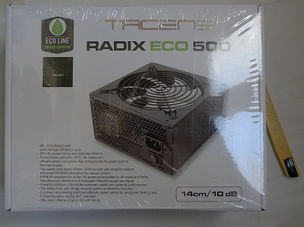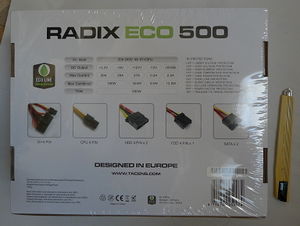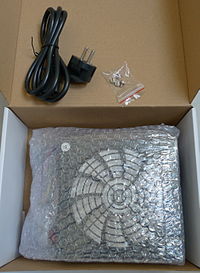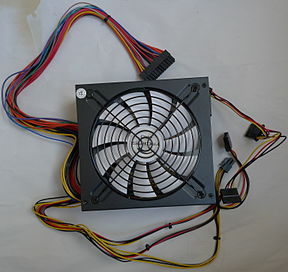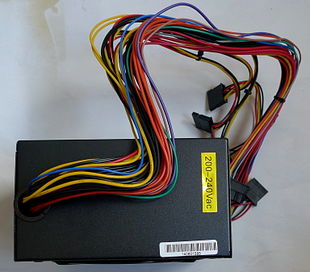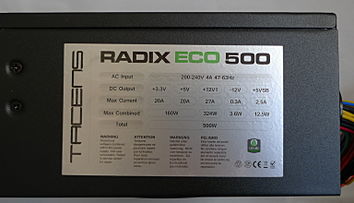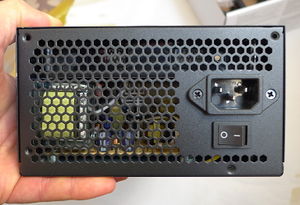Choosing a Power Supply for your RepRap
The power supply (PSU or Power Supply Unit) is a most essential component of any RepRap, yet the information over which PSU to choose/buy for RepRap use is very much scattered around the web, in YouTube videos, and in various forums, blogs and wikis. Also there is little information concerning safety issues and these should be the absolute priority when dealing with PSUs.
The purpose of this page is to help the RepRap builder choose a proper PSU for her/his project, possibly modify it slightly to function with his choice of RepRap electronics, and deal with any safety concerns that may arise related to the PSU.
Contents
- 1 Switch-mode power supplies, a short introduction
- 2 LED strip PSUs or ATX PSUs ?
- 3 PSU power requirements for RepRap use
- 4 What to look for in an ATX PSU for your RepRap project
- 5 Ten Quick Steps to Modifying an Inexpensive ATX PSU for RepRap Use - with pictures!
- 6 Using an ATX PSU for your RepRap project without modifying it
Switch-mode power supplies, a short introduction
Nowadays (2014) practically all power supplies within the power range required by RepRap printers are switch-mode power supplies (as opposed to linear power supplies, which are considered outdated). Switch-mode power supplies have relatively complex circuits that convert mains AC electricity to the DC voltages required by RepRap steppers and electronic circuits. The design and manufacturing of switch-mode power supplies is way beyond the reach of any hobbyist, leaving a single alternative for RepRap builders: to buy a commercial switch-mode PSU.
LED strip PSUs or ATX PSUs ?
Both are switch-mode power supplies. Economies of scale play an important part in determining the price and availability of a switch-mode power supply. So when looking to buy a PSU for her/his RepRap, the RepRap builder has in reality just two choices: what can be called the LED strip PSU, or a modern ATX PSU.
LED strip PSUs
LED strip PSUs are switch-mode PSUs designed to supply a fixed DC 12V or 24V rail with relatively high current capabilities (anywhere from 15A to 30A or more) to a strip of dozens or hundreds of LEDs, each consuming a small percentage of the total current. In the last couple of years, due to the development of LED lighting, they have become relatively inexpensive and are now widely available. They are even currently included in many commercial RepRap kits. However, one must keep in mind their original design requirements: powering LEDS is not a particularly difficult task, as these are relatively forgiving electronic devices. Also, since LED strip PSU manufacturers are not forced to comply with any specific requirements or standards apart from the basic ones that will get them through the usual test laboratories certifications, there is a big variation in quality and price, and it is practically impossible for the hobbyist to choose one LED strip PSU over another on any rational basis.
ATX PSUs
ATX PSUs on the other hand have been around for decades and have evolved over time, adapting to the ever-changing PC market. There is an "official" ATX PSU design guide / specification that is revised every few years and that is available as a PDF document for free download. ATX PSU manufacturers can claim that their products conform to these specifications (or not) as this is seen as an attractive feature for consumers. The latest ATX specification revisions include not only precise technical specifications, but also a number of safety requirements as well as some ergonomic requirements. ATX PSUs get regularly opened and dissected in specialized hobbyist websites (JonnyGuru, TechPowerUp, HardwareSecrets, etc), and some brands have established themselves as having reliable products with a good price/performance ratio. So all in all, there is a lot more information available to the hobbyist to make a rational choice when choosing an ATX PSU.
Comparison table
The following table compares LED strip PSUs vs ATX PSUs for RepRap use:
| LED Strip PSUs | ATX PSUs | |
|---|---|---|
| Availability | widely available | very widely available |
| Price | $20-$120 | $20-$200 |
| Power | 200W-400W | 200W-600W |
| PFC | No (not required) | Passive or Active PFC (or no PFC) available |
| Thermally regulated fan | No (not required) | Yes (12 or 14cm diameter) |
| Guaranteed minimum efficiency | No (not required) | Yes |
| Cables included | No | Yes |
| Low ripple/noise DC output | No (not required) | Yes |
| Excellent load/line regulation | No (not required) | Yes |
| Requires modifications for RepRap use | No | Depends, but in general, a few simple modifications (and this voids warranty) |
| Protections | Few(?) | Many |
| Remote softstart and standby | No | Yes |
| On/Off switch | No (usually) | Yes (usually) |
| 24V versions available | Yes | No |
| Established brands | No | Yes |
PSU power requirements for RepRap use
RepRap electronics (e.g. the ubiquitous Arduino Mega 2560 + RAMPS_1.4 combo) usually require +12V to function and the same voltage is used for the heated bed (if present), extruder heater(s) and steppers. Each electrical or electronic part draws a certain current and by totaling these currents and using the formula Power (Watts) = Voltage (V) x Current (A), we get the power requirements for our PSU, whether we are using an LED strip PSU or an ATX PSU (for the 12V rail, see below). Following good engineering practices means we'll also add a safety margin and slightly overspecify our PSU power requirements.
Another way to calculate our total current and hence total power requirements for the PSU is to check the fuse or fuses that protect our RepRap. For example, on a RAMPS_1.4 board there are two PTC resettable fuses: one is a 5A fuse for the electronics, extruder(s) and steppers, the other one is an 11A fuse exclusively for the heatbed. So the maximum current draw from our Arduino Mega 2560 + RAMPS_1.4 combo would be 16A. We'll add a 25% safety margin and that gets us to 20A, or 12V x 20A = 240W. So, we should look for a PSU that can deliver a minimum of 20A @ 12V = 240W. However note that you should not necessarily select a PSU that just meets these power ratings, as it would operate near its maximum capacity. Anything that exceeds these power requirements will work but if you can afford it, buy a PSU that exceeds the minimum power requirements by 30% or more.
What to look for in an ATX PSU for your RepRap project
There are scores of ATX PSUs that will fit within any power range, from various brands and in various lines. To help with your choice of ATX PSU for your RepRap project, here is a short list of desirable features:
- Exceeds the minimum power requirements by 30% or more on its 12V rail(s).
- Has PFC. Preferably active PFC.
- Has a temperature controlled fan, 12cm (good) or 14cm (better).
- Has a guaranteed efficiency rating. Nowadays (2014) manufacturers have standardized over some efficiency labels such as Bronze, Silver, Gold and Platinum. Bronze is more than good enough for RepRap use.
- Has a Power On/Off switch.
- Comes from a generally recognized manufacturer and has received positive reviews from hobbyist websites (such as those mentioned above).
Once you have decided on a realistic budget, it should be easy to order an adequate ATX PSU for your RepRap project online. One tip: don't even waste time considering ATX PSUs at the "bottom of the heap" i.e. those $20 noname ATX PSUs you can find on eBay, or some old second hand ATX PSU. For a few more dollars or euros you can probably find much better quality stuff, new in the box, and that's what you'll want to buy.
Ten Quick Steps to Modifying an Inexpensive ATX PSU for RepRap Use - with pictures!
Let's get hands on with an ATX PSU for our RepRap! In this case I took pictures of the modifications I made to an inexpensive ATX PSU I bought here in Spain in September 2014 for my P3Steel RepRap project, which uses the ubiquitous Arduino Mega 2560 + RAMPS 1.4 combination as its electronics.
Unboxing
Here is the ATX PSU, still in its fancy box:
The back of the box lists the technical specifications and features for this ATX PSU. Note that despite the fancy box, this particular ATX PSU model only has passive PFC (doh!) and no guaranteed efficiency rating (bummer!), but it has a 140mm thermally regulated fan (good!) and it's painted black (just kidding!).
Let's take it out of the box and check what's included:
Well, we have the ATX PSU properly packaged in bubble wrap, a power cable (EU type), a small plastic bag with four screws and... no manual or warranty certificate! The cables could be a little bit longer but they have an adequate length for RepRap use. They are not sleeved, but we'll work around that later. Also note there is a plastic protection for the cables exit from inside the PSU. And finally: 200~240V AC only (which is fine for Spain and most of the EU).
The label on one of its sides indicates the maximum power available for each rail. For RepRap use, the relevant figure we have to look for is the rating for the 12V rail, in this case, 27A or 324W: we are good! Also note the back of the ATX PSU has a proper On/Off switch and power cord receptacle. Again, good.
Preliminary Test
It's always a good idea to make a simple, quick preliminary test of our just unboxed ATX PSU i.e. turn it On and check that it does work indeed and that we get the correct voltages on all its outputs.
Using an ATX PSU for your RepRap project without modifying it
This is possible but requires the purchase of some extra components which may not be easily available. Basically we'll need a female 24-pin to male 20-pin adapter cable and a couple of female Molex connectors.
